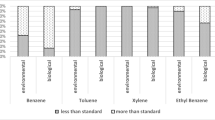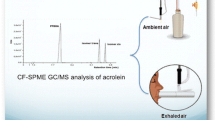Abstract
Occupational exposure to inhalational anesthetics occurs routinely in operating rooms. It could induce serious health hazards and diseases. This exposure assessment is a crucial step in determining risks. In this study, a pen-shaped holder for solid-phase microextraction (SPME) sampler was successfully applied as a time-weighted average sampling tool for workshift exposure assessment of operation room staff to halothane. It proved to be very convenient for use in occupational environments such as operation rooms. Samples were analyzed by a gas chromatography–mass spectrometry. The validity of the SPME method was checked in real-world conditions with Occupational Safety and Health Administration (OSHA) 103 standard method for the determination of inhalational anesthetics. A good agreement between OSHA 103 and SPME methods was obtained and results demonstrated no statistically significant differences in anesthetic concentrations determined by the two analytical methods (p ≥ 0.05). It is concluded that SPME in retracted mode could successfully be applied in occupational exposure assessment purposes.




Similar content being viewed by others
References
Barash, P. G., Cullen, B. F., Stoelting, R. K., & Stock, M. C. (2009). Handbook of clinical anesthesia. Baltimore: Lippincott Williams & Wilkins.
Bergemalm-Rynell, K., Strandberg, B., Andersson, E., & Sällsten, G. (2008). Laboratory and field evaluation of a diffusive sampler for measuring halogenated anesthetic compounds. Journal of Environmental Monitoring, 10(10), 1172–1178.
Brown, R., Harvey, R., Purnell, C., & Saunders, K. (1984). A diffusive sampler evaluation protocol. American Industrial Hygiene Association Journal, 45(2), 67–75.
Chen, Y., & Pawliszyn, J. (2004). Solid-phase microextraction field sampler. Analytical Chemistry, 76(22), 6823–6828.
Dascalaki, E. G., Lagoudi, A., Balaras, C. A., & Gaglia, A. G. (2008). Air quality in hospital operating rooms. Building and Environment, 43(11), 1945–1952.
Davenport, H., Halsey, M., Wardley-Smith, B., & Bateman, P. (1980). Occupational exposure to anaesthetics in 20 hospitals. Anaesthesia, 35(4), 354–359.
Eisert, R., & Pawliszyn, J. (1997). New trends in solid-phase microextraction. Critical Reviews in Analytical Chemistry, 27(2), 103–135.
Fuller, E. N., Schettler, P. D., & Giddings, J. C. (1966). New method for prediction of binary gas-phase diffusion coefficients. Industrial and Engineering Chemistry, 58(5), 18–27.
Gorecki, T., & Namiesnik, J. (2002). Passive sampling. Trends in Analytical Chemistry, 21(4), 276–291.
Hewett, P. (2001). Industrial hygiene exposure assessment-data analysis and interpretation. Washington DC: American Chemical Society.
Hoerauf, K., Funk, W., Harth, M., & Hobbhahn, J. (1997). Occupational exposure to sevoflurane, halothane and nitrous oxide during paediatric anaesthesia waste gas exposure during paediatric anaesthesia. Anaesthesia, 52(3), 215–219.
Irwin, M. G., Trinh, T., & Yao, C. L. (2009). Occupational exposure to anaesthetic gases: A role for TIVA. London: Informa Healthcare.
Isetun, S., Nilsson, U., Colmsjö, A., & Johansson, R. (2004). Air sampling of organophosphate triesters using SPME under non-equilibrium conditions. Analytical and Bioanalytical Chemistry, 378(7), 1847–1853.
Jaloszyski, P., Kujawski, M., Wsowicz, M., Szulc, R., & Szyfter, K. (1999). Genotoxicity of inhalation anesthetics halothane and isoflurane in human lymphocytes studied in vitro using the comet assay. Mutation Research, Genetic Toxicology and Environmental Mutagenesis, 439(2), 199–206.
Khaled, A., & Pawliszyn, J. (2000). Time-weighted average sampling of volatile and semi-volatile airborne organic compounds by the solid-phase microextraction device. Journal of Chromatography A, 892(1–2), 455–467.
Korczynski, R. (1999). Anesthetic gas exposure in veterinary clinics. Applied Occupational and Environmental Hygiene, 14(6), 384–390.
Koziel, J., Jia, M., & Pawliszyn, J. (2000). Air sampling with porous solid-phase microextraction fibers. Analytical Chemistry, 72(21), 5178–5186.
Martin, J. L. (2005). Volatile anesthetics and liver injury: A clinical update or what every anesthesiologist should know. Canadian Journal of Anesthesia/Journal canadien d'anesthésie, 52(2), 125–129.
Mazur, J., Podolak, G., Esposito, G., Rinehart, D., & Glenn, R. (1980). Evaluation of a passive dosimeter for collection of 2-bromo-2-chloro-1, 1, 1-trifluoroethane and 2-chloro-1, 1, 2-trifluoroethyl difluoromethyl ether in hospital operating rooms. American Industrial Hygiene Association Journal, 41(5), 317–321.
Musshoff, G., Junker, H., & Madea, B. (2000). Rapid analysis of halothane in biological samples using headspace SPME and GC-MS—a case of double homicide. Journal of Analytical Toxicology, 24(5), 372–376.
Occupational Safety and Health Administration (OSHA). (2010). Chemical sampling information: Halothane. http://www.osha.gov/dts/chemicalsampling/data/CH_244300.html.
Otedo, A. (2004). Halothane induced hepatitis: Case report. East African Medical Journal, 81(10), 538.
Ouyang, G., & Pawliszyn, J. (2006). SPME in environmental analysis. Analytical and Bioanalytical Chemistry, 386(4), 1059–1073.
Poli, D., Bergamaschi, E., Manini, P., Andreoli, R., & Mutti, A. (1999). Solid-phase microextraction gas chromatographic-mass spectrometric method for the determination of inhalation anesthetics in urine. Journal of Chromatography B: Biomedical Sciences and Applications, 732(1), 115–125.
Risticevic, S., Niri, V. H., Vuckovic, D., & Pawliszyn, J. (2009). Recent developments in solid-phase microextraction. Analytical and Bioanalytical Chemistry, 393(3), 781–795.
Smith, F. D. (2010). Management of exposure to waste anesthetic gases. Association of Operating Room Nurses Journal, 91(4), 482–494.
Tsai, S. W., & Chang, T. A. (2002). Time-weighted average sampling of airborne n-valeraldehyde by a solid-phase microextration device. Journal of Chromatography A, 954(1–2), 191–198.
Tsai, S. W., & Kao, K. Y. (2006). Diffusive sampling of airborne furfural by solid-phase microextraction device with on-fiber derivatization. Journal of Chromatography A, 1129(1), 29–33.
Tuduri, L., Desauziers, V., & Fanlo, J. L. (2001). Potential of solid-phase microextraction fibers for the analysis of volatile organic compounds in air. Journal of Chromatographic Science, 39(12), 521–529.
Wardencki, W., Curylo, J., & Namiesnik, J. (2007). Trends in solventless sample preparation techniques for environmental analysis. Journal of Biochemical and Biophysical Methods, 70(2), 275–288.
Wiesner, G., Hoerauf, K., Schroegendorfer, K., Sobczynski, P., Harth, M., & Ruediger, H. W. (2001). High-level, but not low-level, occupational exposure to inhaled anesthetics is associated with genotoxicity in the micronucleus assay. Anesthesia and Analgesia, 92(1), 118.
Wiesner, G., Schiewe-Langgartner, F., Lindner, R., & Gruber, M. (2007). A low-level occupational exposure to sevoflurane is associated with genotoxicity in the sister chromatid exchange but not in the micronucleus assay: 9AP6-5. European Journal of Anaesthesiology, 24, 121.
Zare Sakhvidi, M. J., Bahrami, A. R., Ghiasvand, A. R., Mahjub, H., & Tuduri, L. (2011). Determination of inhalational anesthetics in field and laboratory by SPME GC/MS. Analytical Letters. (in press)
Zenz, C. (1984). Reproductive risks in the workplace. National Safety News, 130(3), 38–46.
Acknowledgments
The authors thank the Hamadan University of Medical Science for supporting this research. The authors also extend their appreciation to Mr. Mohammad Taghi Zare Sakhvidi for his kind cooperation with the research team for sampling in operating rooms.
Author information
Authors and Affiliations
Corresponding author
Rights and permissions
About this article
Cite this article
Zare Sakhvidi, M.J., Bahrami, A., Ghiasvand, A. et al. Field application of SPME as a novel tool for occupational exposure assessment with inhalational anesthetics. Environ Monit Assess 184, 6483–6490 (2012). https://doi.org/10.1007/s10661-011-2434-7
Received:
Accepted:
Published:
Issue Date:
DOI: https://doi.org/10.1007/s10661-011-2434-7




